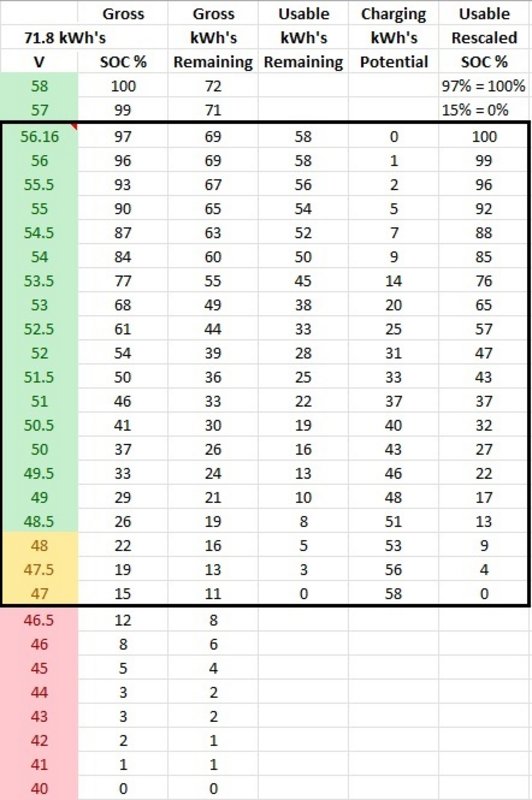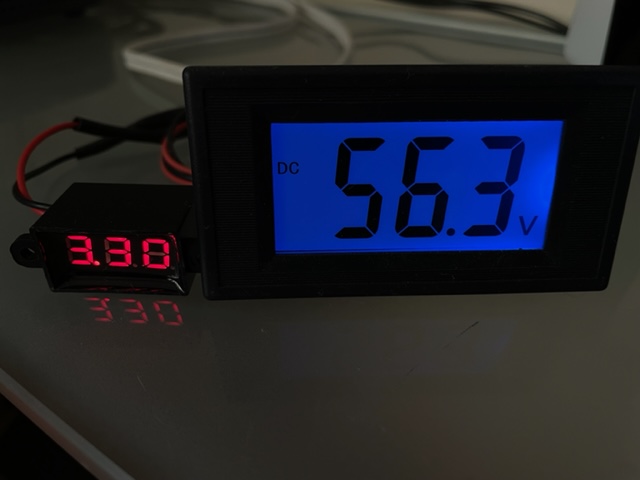Page 1 of 2
Monitoring Battery Capacity
Posted: Wed Jan 24, 2024 3:46 pm
by cycling_mike
A newbie question so go easy.
So how do you guys (and others) measure the capacity of your batteries. I appreciate the cells lose storage over time but not sure how to measure the current storage capacity of my batteries.
I have a LuxAC3600 invertor and (nominally at least) 9.6kWh of battery storage (3* HanchuEss 3.2kWh units).
I could wait until the batteries fully discharge and see how much power they take in a charging cycle - the Luxpower app tells me this. This seems a bit empirical but I don't see another way.
The app tells me I have battery capacity of 151Ah but this does not seem to relate to the nominal kWh rating in any way that I can see. Am I missing something?
My supplemental is does battery temperature effect storage total capacity or just charging/discharging rate?
Thanks..

Re: Monitoring Battery Capacity
Posted: Wed Jan 24, 2024 3:56 pm
by Stinsy
The Ah figure is what the batteries tell Lux over the data connection. Whether this is the same as the marketing goon wrote on the box is for you to figure out!
You might be able to connect a raspberry pi to the batteries and get a SoH figure. You could also use a clamp meter or data from your inverter to guess capacity.
As far as I am able to measure the capacity of my Pylontechs is the same as new and they’re in their 5th year.
Re: Monitoring Battery Capacity
Posted: Wed Jan 24, 2024 3:59 pm
by Krill
Given entropy, your proposed method doesn't actually work. The amount of energy in is not the same as the most of energy out.
If I was going to test, I'd disconnect the batteries from a house load and then run a standard 1kW heater and see how long the inverter lasted for (even then you would have to account for the inverter inefficiency but this is reported in the technical specification).
To be clear: I've had my house stack for 9 months now and I have no cloue exactly how much they hold, but this doesn't matter to me. What matters is that I know how long it lasts with general household use.
I'm sure nowty will come along and explain the point that storage capacity and discharge rates are inherently linked due to the electrochemistry (the coler it is, the less power is produced for each part of hte chemical reaction, and "storage capacity" could be defined in terms of the amount of molecules that are yet to react and release energy, but we can't measure for this without destructive testing of hte batteries).
Re: Monitoring Battery Capacity
Posted: Wed Jan 24, 2024 4:24 pm
by marshman
151Ah @ a nominal 50V = 7550Wh or 7.55kWh
Only real way is to "coulomb count" or fully charge and then measure how much energy you can extract when discharging form full charge to your lower limit.
Re: Monitoring Battery Capacity
Posted: Wed Jan 24, 2024 4:43 pm
by AlBargey
Well if each battery is 3.2kWh:
3200Wh / 51.2v = 62.5Ah x 3 batteries = 187.5Ah Total storage capacity 48v to 57.6v
If they're meant to be 187.5Ah and are now 151Ah, you have 36.5Ah missing, or 19.5% reduction in capacity.
What is the discharge limit 48v or 49.6v etc, higher voltage limit would mean a little less capacity.
Are they cycled hard daily, and then kept at 57.6v for extended periods, maybe SOH isn't great? It could just be they are unbalanced and need a decent charge to give them time to balance properly.
I have a Victron SmartShunt, so I can do a discharge test after fully charging and just see how much I can discharge from them over a few hours until the inverter or BMS shut off.
Does the software not show a rough kWh out as well as in if you don't have a shunt?
Re: Monitoring Battery Capacity
Posted: Wed Jan 24, 2024 4:47 pm
by nowty
Krill wrote: ↑Wed Jan 24, 2024 3:59 pm
I'm sure nowty will come along and explain the point that storage capacity and discharge rates are inherently linked due to the electrochemistry (the coler it is, the less power is produced for each part of hte chemical reaction, and "storage capacity" could be defined in terms of the amount of molecules that are yet to react and release energy, but we can't measure for this without destructive testing of hte batteries).
No, I use a spreadsheet and read off the stack voltage.

if I'm heavily charging / discharging I add or subtract a bit based on my experience.
NOTE - No one else should use these numbers as you won't have a battery bank like mine.

And I have a voltage monitor in my lounge so I can easily see it.

Re: Monitoring Battery Capacity
Posted: Wed Jan 24, 2024 5:09 pm
by AlBargey
Just as a side not to Nowty's voltage reference spreadsheet, knowing 100% SOC or the risk of overcharging gets complicated with absorption times and end amps, tail current, termination current, whatever you want to call it. LiFePO4 can be charged to 100% with a charge voltage @ 3.4v per cell or up to 3.65v per cell, depending on the tail current at the end of charge, it just takes longer with a lower absorption voltage and the necessary lower tail current.
Good article here on Lithium charging:
*Edit - broken link
https://nordkyndesign.com/charging-mari ... ery-banks/
Re: Monitoring Battery Capacity
Posted: Wed Jan 24, 2024 6:23 pm
by cycling_mike
Thanks all
Feel like I am going down a bit of a rabbit hole here, as ever answers come at multiple levels of complexity.
Krill makes a valid point,
Krill wrote: ↑Wed Jan 24, 2024 3:59 pm
To be clear: I've had my house stack for 9 months now and I have no cloue exactly how much they hold, but this doesn't matter to me. What matters is that I know how long it lasts with general household use.
My batteries do cover our general household use so why worry. But the apps reporting of Ah did fall from 160Ah to 151Ah some while back and this has got me concerned.
AlBargey wrote: ↑Wed Jan 24, 2024 4:43 pm
Well if each battery is 3.2kWh:
3200Wh / 51.2v = 62.5Ah x 3 batteries = 187.5Ah Total storage capacity 48v to 57.6v
If they're meant to be 187.5Ah and are now 151Ah, you have 36.5Ah missing, or 19.5% reduction in capacity.
What is the discharge limit 48v or 49.6v etc, higher voltage limit would mean a little less capacity.
The discharge limit is 40v, that seems OK
AlBargey wrote: ↑Wed Jan 24, 2024 4:43 pm
Are they cycled hard daily, and then kept at 57.6v for extended periods, maybe SOH isn't great? It could just be they are unbalanced and need a decent charge to give them time to balance properly.
At this time of year they are cycled each day, a daily charge to 100% at cheap rate, this is consumed over the day to about 10%. In the summer my panels supply all I need so no need so no AC charging.
At the time of writing my three batteries are discharging and showing
SOC 61.1% 52.9v
SOC 62.9% 52.9v
SOC 64.7% 52.9v
do these look in balance?
AlBargey wrote: ↑Wed Jan 24, 2024 4:43 pm
Does the software not show a rough kWh out as well as in if you don't have a shunt?
Not that I have spotted.
Re: Monitoring Battery Capacity
Posted: Wed Jan 24, 2024 6:38 pm
by Fintray
Hi Al, went to look at the article but you have linked back to this thread, think the one you meant is below.
https://nordkyndesign.com/charging-mari ... ery-banks/
Re: Monitoring Battery Capacity
Posted: Wed Jan 24, 2024 7:01 pm
by AlBargey
cycling_mike wrote: ↑Wed Jan 24, 2024 6:23 pm
The discharge limit is 40v, that seems OK
40v = 2.5v per cell - The absolute minimum you should ever take an LFP cell down to, if you can increase to 3v or 3.1v (48-49.6V) your batteries will last longer, there's also very little capacity in that small lower voltage knee.
*Edit - Just to clarify, is that your charge settings or BMS settings - it's fine for the battery BMS but not ideal for charge settings, same for the voltages I mention below.
cycling_mike wrote: ↑Wed Jan 24, 2024 6:23 pm
At the time of writing my three batteries are discharging and showing
SOC 61.1% 52.9v
SOC 62.9% 52.9v
SOC 64.7% 52.9v
do these look in balance?
That's just how the batteries are 'balanced' to each other and shows their SOC algorithms accuracy or lack of (But could be a sign of weaker cells in the lower two) , but not how the individual battery cells are balanced to each other in the individual batteries, which you can only see in the upper voltage knee when charging above 3.42v per cell. Can you see cell level readings? What is the deviation in voltage of the cells when they are close or at 100%? It should be less than 30mV difference between the lowest and highest cells if they are well balanced.
If you're leaving 10% SOC then that should be OK, but running them really hard everyday down to 2.5v per cell would definitely lower the SOH more quickly, and if they are also charging up to 2.65v per cell that will also help wear them out more quickly. It seems general consensus for longevity is charging up to 3.45-3.50v per cell with the appropriate tail current, or absorption time to get the same outcome, all assuming they are LFP not NMC, liPO or something else.
If you can log in online or connect to a laptop to get more info somehow, it's probably a good idea.


